Tech Giants: Snöball’s Rachel Stephan on the Power of Word-of-Mouth Marketing to Fill Seats and Grow Audiences Year-Round

Having worked in advertising and marketing agencies in her native Lebanon, then for an event publishing company in Montreal, Rachel Stephan launched her own event marketing agency in 2001—yet she always wanted to create a tech product that would become her legacy.
Her “aha moment” came in 2015 after seeing the successful results of the unique word-of-mouth campaigns her company was running.
“I thought, ‘How can we scale this? How can we better measure it?’” she said. “One summer, we created our first pilot of the project, and my software engineer said nonchalantly, ‘Let’s call it ‘Boule de Neige,’' which literally translates to ‘snowball,’ and that was exactly what our tech did: snowball event attendance. Period.”
Landing on Snöball, the Swedish spelling of the word for the new product, Stephan quite literally got the word out at the encouragement of her friend and industry colleague, Dahlia El Gazzar.
“She encouraged me to “SHIP IT,” as Seth Godin would say, so I submitted Snöball to the IMEX Startup Competition, the Event Technology Awards and the IBTM World Tech Watch Awards, and we were finalists in all of them,” she said. “The rest just simply 'snöballed' from there.”
We sat down with Stephan to discover how her word-of-mouth marketing and audience growth strategy excels for events and year-round engagement, challenges and trends she is seeing in event marketing and the most important lessons she has learned along the way as an event tech founder.
What sets Snöball apart as a community marketing and audience growth platform for event professionals?
Snöball is the most comprehensive word-of-mouth marketing tool dedicated to events. I am biased, I know, but I am repeating what clients tell us once we show them Snöball. We built it to allow as much flexibility as possible and to run a diverse type of audience-based campaigns—pre-event to post-event. We know that people need multiple nudges and reminders to act, and Snöball is the only platform that activates the audience as advocates not only at registration but with multiple reminder campaigns leading up to the event.
Since it is about empowering the voices of your own people to amplify your events, Snöball is the only one able to provide a curation feature to capture speakers’ soundbites and teasers to promote their sessions.
In addition, with our recent partnership with CLIPr, we now can leverage past event content, amplifying it via Snöball to help not only drive attendance growth but also audience growth and engagement.
These are only a few of the use cases that demonstrate how marketers can leverage the power of word of mouth and their communities to run campaigns for membership drives, awards, lead generation, etc.
What are the biggest event marketing pain points event professionals are experiencing nowadays, particularly as the industry moves out of the pandemic, and how is Snöball helping them address and overcome them?
[The biggest challenges include] getting butts in seats and convincing people to get on a plane and take time away from the office and from their families to go to an in-person event. Enter the marketing of persuasion. Attention and retention are also big challenges post-pandemic. People have moved around a lot, and that audience that we marketed to before is not enough to hit the registration numbers we hope for. How can marketers tap into a new audience? How can they attract the right type of audience? How can they find lookalike attendees? As they say, birds of same feather flock together. Snöball helps marketers attract similar audiences to their existing ones by tapping into that audience’s community and circle of influence.
Why is it so important for event professionals to put their audience at the core of their event marketing campaigns?
People connect with people and trust people, not brands. Watch the engagement on your LinkedIn company page versus the same post shared from someone at that same company. According to Neilson, 92% of people trust recommendations from friends and family over any other type of advertising.
Some of the many challenges facing event marketers are time, resources and limited budgets. Enrolling their participants, speakers, sponsors and exhibitors as brand ambassadors with influence to attract registrants is one way to work smarter not harder. Snöball helps amplify their reach, not their budget.
Event marketing-wise, what are the most important necessities for pulling off the most successful virtual, hybrid or in-person event?
Once thing I’d say is that post-pandemic, we are all short on attention and can see through marketing speak. One of the positive things that came out of the pandemic is that it brought relationships back to the basic level. We’re all human with shared values, and we appreciate authenticity. People became more vocal and shared more about the challenges they have and what they would like to see. So, listening to your community and marketing in the way they speak and exchange with each other will make your content (and event) more relevant and relatable, no matter what type of event you put on.
There are multiple factors that can influence a successful campaign. The most successful campaigns are when the client is open to exploring the value in leveraging all audience segments as well as their unique role in promoting the event. It's when they are not only focusing on attendees or speakers, but sponsors, exhibitors, internal teams, committees, volunteers—everyone has influence. When all your stakeholders are talking about your event, social proof is sky high, so are conversions and reach. In one instance, one exhibitor was responsible for referring 672 registrations.
With Snöball, marketers can know exactly who referred who and where on social media they converted from. Knowing this allows them to incentivize their Most Valued Advocates (MVA). People are competitive in nature, and having different prizes for the different audience segments also helps boost engagement.
The untapped strategy is a post event activation, where the marketer can leverage the event content to drive signups to an on-demand library by getting their audience to be the amplifiers of that message. Not only will this help monetize existing content, this activation will also help build attendance for the next event.
How are you helping your clients uniquely increase engagement for the event and year-round?
There is a shift in mindset and the way we approach events and marketing. We help our clients to think big picture, long-term marketing strategy when it comes to an event. It’s shifting from a one-time event to ongoing activations that nurture the relationship between the organization and its audience. Yes, clients come to us with one focus, boosting their registration numbers, which are not where they used to be prior to the pandemic. Our role is to also help them see what they can do during and after the event to keep the momentum going and provide value to their stakeholders. Now more than ever, organizers have a tremendous amount of content that can be used and reused to serve both attendee and audience growth.
What are the biggest trends currently defining event tech and event marketing in particular?
During the pandemic, events proved to be the most effective marketing strategy an organization has ever had. They earned their place in the spotlight. Events as a marketing strategy can help organizers with lead generation, building relationships and community. This provides value and audience proximity to their partners in addition to a source of content that can serve as a year-round communication strategy. Now, big trends are emerging in how these events are delivered, from digital, to in-person, to blended experiences for its audience. And of course, one cannot talk about event trends without mentioning the metaverse, which is in itself another dimension to be explored. To sum it all up, I would say community, co-created content and continuous event experiences are the main trends I see emerging at the moment.
What are some of the biggest lessons you’ve learned in your career in event tech, particularly as a female leader in a male-dominated space?
Surround yourself with people who would support you in your ups and downs. The road of a founder is bumpy, with both highs and lows occurring in the same day. Stay focused on the bigger picture and never lose sight of your “why.” There is a famous quote by Reid Hoffman, the founder of LinkedIn, which really resonates with me: “If you are not embarrassed by the first version of your product, you’ve launched too late. I am a perfectionist and that sometimes is a curse.” Once I get to showcase what Snöball is capable of doing, I am often reminded that what we built, and continue to build, already has immense value for marketers. If you are a tech founder reading this, take a moment and tap yourself on the shoulder—you have done amazing things.
Don’t miss any event-related news: Sign up for our weekly e-newsletter HERE, listen to our latest podcast HERE and engage with us on Twitter, Facebook and LinkedIn!


Add new comment